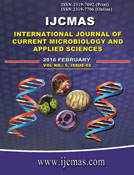


 National Academy of Agricultural Sciences (NAAS)
National Academy of Agricultural Sciences (NAAS)

|
PRINT ISSN : 2319-7692
Online ISSN : 2319-7706 Issues : 12 per year Publisher : Excellent Publishers Email : editorijcmas@gmail.com / submit@ijcmas.com Editor-in-chief: Dr.M.Prakash Index Copernicus ICV 2018: 95.39 NAAS RATING 2020: 5.38 |
Since biofilms have been considered as a virulence factor contributing to the Candidal infection, a reliable method for their diagnosis is necessary. In this study, we screened 100 clinical isolates of Candida spp. by Congo Red Agar Method, Test Tube method and Micro titer Plate Method. Biofilms have great significance in public health, because biofilm-associated Candida exhibit dramatically decreased susceptibility to antimicrobial agents. This susceptibility may be intrinsic (as a natural outcome of growth in the biofilm) or acquired (due to transfer of extra chromosomal elements to susceptible organisms in the biofilm). It is likely that biofilms evade anti microbial challenges by multiple mechanisms. In this study 57% of the clinical Candida isolates showed Biofilm production by Test tube method. It was found that C. albicans had a little lower percentage of biofilm positivity (4/9 = 44.4%) as compared to non-albicans Candida spp. (53/91 = 58.2%). Antifungal efficacy of Coconut oil and Eucalyptus oil was also tested in this study against all Candida isolates. Eucalyptus oil was observed to be a better antifungal agent than Coconut oil in the present study. When coconut oil was tested against all Candida albicans isolates, the sensitivity of biofilm non producers was higher in comparison to biofilm producers.
 |
 |
 |
 |
 |